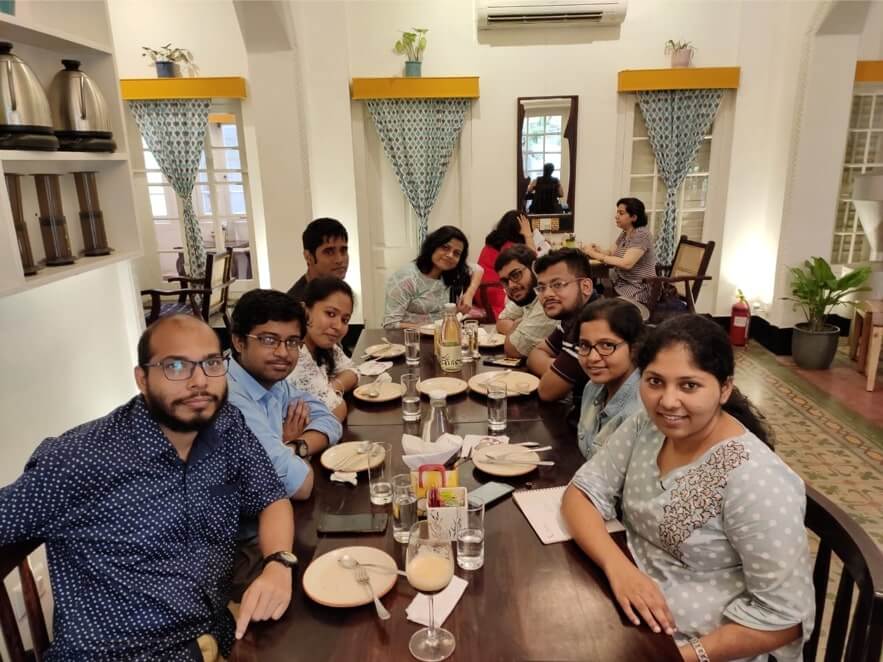Dr. Neelanjana Sengupta: Probing into life, with computational tools
WIISER : Women in Science at IISER
Shrestha Chowdhury and Srujana Mohanty

Dr. Neelanjana Sengupta is an Associate Professor in the Department of Biological Science at IISER Kolkata. In this electronic interview, she talks about the stereotypes pertaining to girls doing physical and mathematical sciences and how she managed to break free from them.
Tweet
1. What inspired you to be a scientist? Scientist Dr. Marie Curie wanted to be a poet in her young days. If not a scientist, what would you have been?
As a child, I had a vivid imagination. My aspirations for the future were of various hues. A doctor was, of course, something I imagined an adult-me would become, but for a longish time, I did nurse ambitions of becoming an astronaut (possibly after reading about Valentina Tarashkova). And on it went. I had a flair for writing and music, and had I worked harder to hone those skills; I may have done reasonably well. All along, I had the habit of questioning things and rationalizing observations – a trait that has stayed with me.
Somehow, I never meticulously ‘planned’ a scientist’s career---the best things have panned out regardless!
2. A notion prevails that Physical and Mathematical sciences are not the field for young girls. However, in today's world, we find many who are breaking such stereotypes and moving forward, but the number remains low. Throughout your erstwhile student and professional life, primarily as a computational scientist, how did you build your self-confidence and keep negativities aside?
It is still true that overall, the number of girls opting for the quantitative sciences remains small. I have pondered long about this deficit but have only partially succeeded in deconstructing the reasons. Back in the time, careers in quantitative fields were perceived as economically beneficial, leading some parents to encourage their sons disproportionately. This possibly created a ‘role model vacuum’ for future generations of girls and women. Talented and determined people who managed to push through these (intangible) barriers were perhaps let down by disabling circumstances associated with co-occurring career and family milestones.
I do feel that the situation is now improving, slowly but surely. You may consider me belonging to an ‘intermediary’ generation of female science practitioners, whose family was very ambitious on their behalf but who still lacked suitable role models. One way I managed to bypass this deficit was by focusing on the things at hand and ensuring that I enjoyed what I did. It helps greatly to have a supportive family that believes in you and to be able to yoke your inner creativity and imagination to your existing projects. I do hope (and innately feel) that invisible barriers will cease to exist for the future generations of aspiring female scientists and the search for role models will be a redundant one.
3. Please tell us briefly about your research.
We use physics-based methods to probe the physical and chemical properties of biological molecules and systems computationally. I have alluded to many sub-disciplines here, and indeed our work is highly interdisciplinary. More specifically, we attempt to pry out microscopic interactions between the molecular components in order to predict behavior at a larger scale. For example, in order to understand why the brains of Alzheimer’s disease patients are marked by clumps of proteins, we study the fundamental triggers of the formation and growth of new proteins. My research group website contains specific details of our current projects.
4. With reference to the TEDx talk you delivered at Heritage Institute of Technology, Kolkata, "Is Computational Biology the answer to our health problems?", how does it reflect in this post-COVID world?
When I delivered the TEDx talk in January 2019, little did I know that the world would be hit by a crisis in the shape of Sars-Cov-2 later the same year and that modeling and computational studies would help immensely in understanding and ameliorating the crisis? As the going says, every crisis is a novel opportunity. I just hope that the exceptionally ingenious ways in which clinicians, biologists, data scientists, and quantitative modelers are complementing each other will help us build new and effective paradigms for the current pandemic and beyond.
5. Any words of advice for becoming efficient and deep thinkers of tomorrow?
Be truthful, first and foremost, to yourself. I think that’s the first step towards objective thinking. We appear to live in an increasingly polarized world, and a lot of us are conditioned (perhaps subconsciously) to fight, survive and work to benefit only ourselves. While this mentality may yield short- or medium-term benefits, I believe it impedes one’s intellectual advancement. Rather, I suggest a more holistic approach – think of how you may make a difference not just to your own life and career but also to other individuals and perhaps to societal systems. For example, is your career choice based solely on its perceived monetary value? And of course, read, interact and discuss – ideas mature as they diffuse and collide! And do remember that there are ways to “disagree without being disagreeable”!
This electronic interview was coordinated and conducted by Shrestha Chowdhury and Srujana Mohanty for Cogito137.
Shrestha is currently working as a senior research fellow in Department of Chemistry in IISER Kolkata. She has been a member of the editorial team of Cogito137. She is an avid reader, loves plenty of solitude and possesses fair inclination towards creative projects.
signup with your email to get the latest articles instantly